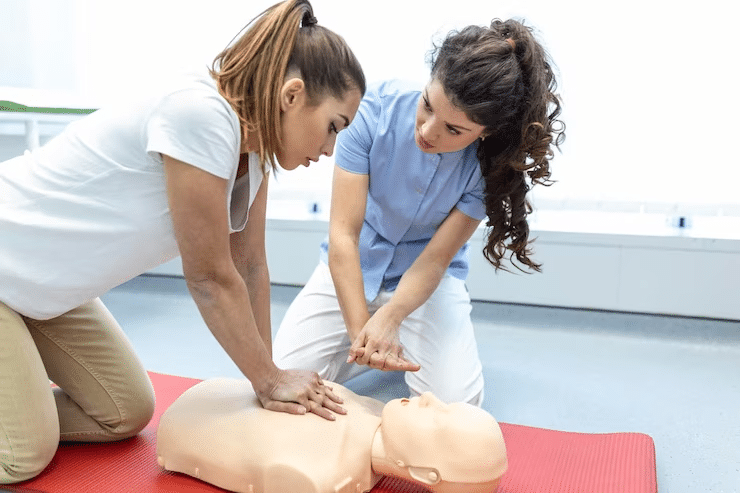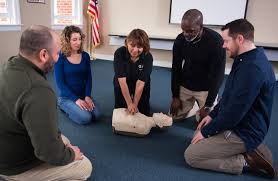Introduction
In today's unpredictable globe, knowing how to react throughout emergency situations can make the difference in between life and fatality. Whether it's an abrupt clinical incident, a crash at home, or a health and wellness situation in a public room, having the right abilities can conserve lives. Get In Emergency Treatment and mouth-to-mouth resuscitation programs-- your essential toolkit for emergencies. These training courses furnish individuals with the knowledge and methods required to handle numerous situations efficiently.
This comprehensive guide will explore every little thing you require to learn about First Aid and mouth-to-mouth resuscitation courses, covering their relevance, what they require, exactly how to obtain certified, and far more. So buckle up; we're about to start a helpful journey that could prepare you for real-life emergencies.
What Are Initial Help and CPR Courses?
First Aid and mouth-to-mouth resuscitation programs offer crucial training on how to react to medical emergency situations efficiently.
Understanding First Aid
- Definition: First aid is the immediate aid offered to a person struggling with a disease or injury until specialist medical help arrives. Key Components: It includes analysis of the situation, stablizing of the client's condition, and executing necessary interventions.
Importance of mouth-to-mouth resuscitation (Cardiopulmonary Resuscitation)
- Definition: Cardiopulmonary Resuscitation (MOUTH-TO-MOUTH RESUSCITATION) is a lifesaving technique made use of in emergencies when somebody's heartbeat or breathing has actually stopped. When It's Needed: Instances consist of heart attack or near-drowning incidents.
These programs incorporate practical skills with theoretical expertise, making certain individuals not just recognize what to do but likewise why those actions are essential.
Why Should You Enroll in a First Aid Course?
Real-Life Application of Skills
The main reason any individual ought to take into consideration signing up in a first aid course is the prospective real-life application of these abilities. Think of experiencing somebody collapse due to a cardiac arrest; understanding exactly how to carry out CPR can be life-saving.
Boosting Confidence in Emergencies
Taking part in these training courses helps construct self-confidence. When confronted with an emergency scenario, having undergone proper training can reduce panic and boost decision-making.
Increased Employability
Many employers now try to find candidates who possess an emergency treatment certification. Whether you're in medical care, education and learning, or even corporate sectors, having this accreditation can give you a side over other applicants.
Components of First Aid and CPR Courses
Basic Life Assistance (BLS)
- Emphasis on maintaining effective breathing and circulation. Techniques such as upper body compressions and rescue breaths are exercised extensively.
Choking Management
- How to identify choking symptoms. The Heimlich maneuver and back impacts are shown as important techniques for displacing an obstruction.
Wound Care
- Understanding different sorts of injuries (cuts, scrapes). Techniques for cleaning wounds and using dressings appropriately.
Recognizing Clinical Emergencies
Participants learn exactly how to determine indications of different medical conditions such as:

- Heart attack Stroke Seizures
How Do You Get Qualified? A Detailed Guide
Choose a Trusted Institution- Look for companies accredited by identified bodies like the American Heart Association (AHA) or Red Cross.
- Decide whether you desire standard emergency treatment training or innovative alternatives like Advanced Cardiovascular Life Support (ACLS).
- Most companies offer on-line registration for convenience.
- Participate actively in both concept and useful sessions to guarantee comprehensive learning.
- A composed exam combined with useful analyses usually figures out qualification eligibility.
- Upon effective completion, you will receive your certification legitimate for a given duration (normally 2 years).
Types of Emergency treatment Surges Available
Standard Emergency treatment Course
Aimed at public participants; covers important skills applicable throughout various scenarios.
Advanced First Aid Course
Designed for those wanting to gain deeper insights right into medical emergency situations; ideal for experts operating in risky environments like building websites or healthcare facilities.
Youth Programs
Tailored specifically for children aged 12-- 17; concentrates on age-appropriate scenarios they may come across at college or home.
CPR Certification: What You Need to Know
Duration of CPR Courses
Typically ranges from 2-- 4 hours relying on the company using them. Some places also supply on-line options that permit you to learn at your very own rate adhered to by hands-on practice sessions.
Certification Credibility Periods
Most certifications need to be renewed every 2 years via correspondence course. This guarantees that your skills continue to be pertinent and updated according to existing guidelines.
Common Myths About Emergency treatment and CPR Training
Myth 1: "I Don't Need Training; I Can Simply Call 911"
While calling emergency situation solutions is important, knowing standard first aid strategies while waiting can dramatically improve results for clients experiencing medical crises.
Myth 2: "Only Medical Professionals Required Accreditations"
Not real! Anyone can benefit from taking emergency treatment training courses-- parents, teachers, trainers-- all play vital functions where emergency situation circumstances might arise.
FAQs Concerning First Aid and CPR Courses
FAQ 1: What Is Covered in a Basic First Aid Course?
A basic first aid course commonly covers topics such as injury care, allergy management, choking help strategies, recognizing indications of heart attacks/strokes/seizures among others.
FAQ 2: Do I Required Any Prior Experience?
No prior experience is necessary! These training courses are made for novices that desire foundational understanding about reacting effectively throughout emergency situations.
FAQ 3: How much time Does It Require To Complete A Course?
Completion times vary based upon layout picked yet usually array from several hours up until one full day relying on depth covered within program scope!
FAQ 4: Exists An Age Demand For Participants?
Most organizations enable individuals aged twelve years old & & over participate securely offered they https://skillstrainingcollege.com.au/course/provide-first-aid-certification-course/ possess parental consent if under eighteen!
FAQ 5: Exactly how Usually Ought To I Restore My Certification?
Certifications usually expire after two years so intend in advance appropriately when organizing refresher classes!
FAQ 6: Will I Receive A Physical Certification After Completion?
Yes! Upon successfully finishing all demands laid out within chosen program-- including assessments-- trainees make their official first aid certificate!

Conclusion
First Help and CPR training courses are very useful tools that everybody must take into consideration contributing to their ability. The ability to act emphatically during an emergency situation not only adds positively towards saving lives but additionally empowers individuals with confidence while browsing unpredicted situations. With different course offerings readily available tailored particularly towards different audiences varying from newbies up until skilled experts looking refreshers-- there's genuinely something out there matched perfect!
So do not CPR training options near me wait any kind of longer; enroll today! Furnish on your own with this crucial toolkit due to the fact that when it comes down saving lives-- every 2nd counts!
